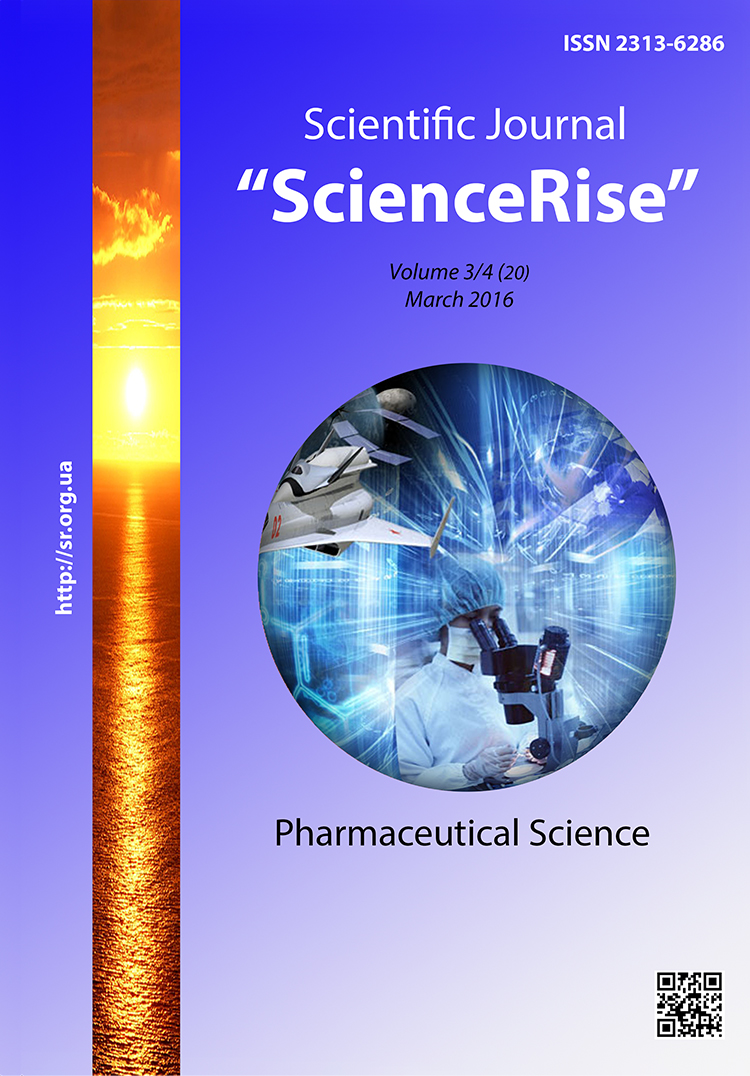Аналіз та управління факторами, що формують фармацевтичну допомогу хворим на цукровий діабет в Україні
DOI:
https://doi.org/10.15587/2313-8416.2016.64836Ключові слова:
фармацевтична допомога, протидіабетичні лікарські засоби, індивідуальна потреба в лікарських засобахАнотація
Мета. Провести аналіз факторів, які формують проблемні питання управління фармацевтичною допомогою хворим на цукровий діабет та обґрунтувати шляхи її оптимізації.
Методи. Маркетингові методи дослідження; методи фармацевтичної інформатики: визначення потреби в інформації, пошуку та систематизації доказової інформації про лікарські засоби, створення фармацевтичних комп’ютерних баз даних; методи синтезу та узагальнення даних.
Результати. За розробленою методикою проведено аналіз теоретичного арсеналу протидіабетичних лікарських засобів в Україні за період 2002–2016 рр. та виявлено його кількісне зростання від 117 до 364 препаратів, при цьому найбільшу динаміку зафіксовано у групі аналогів інсулінів (від 0 до 18 лікарських засобів). На основі аналізу комп’ютерних медикаментозних паспортів хворих на цукровий діабет констатовано недостатнє використання сучасних схем фармакотерапії. Виявлено різке зниження споживання високоефективного протидіабетичного лікарського засобу розіглітазону з 2007 р., припинення споживання у 2010 р, та встановлено вплив на цей процес результатів доказової медицини. Встановлено факт недостатнього оперативного інформування медичних та фармацевтичних спеціалістів в Україні з питань фармацевтичної допомоги хворим на ЦД.
Висновки. Теоретичний арсенал протидіабетичних лікарських засобів в Україні в цілому відповідає міжнародним стандартам та рекомендаціям щодо лікування цукрового діабету, в той час, коли практична фармакотерапія потребує оптимізації. Для визначення перспективної потреби у протидіабетичних лікарських засобах необхідно використовувати результати доказової медицини. Для оптимізації системи фармацевтичної допомоги хворим на цукровий діабет в Україні необхідне створення спеціалізованих аптек та опрацювання програми підготовки їх працівниківПосилання
IDF diabetes atlas – 7th edition. Available at: https://www.idf.org/diabetesatlas
Dovidnyk osnovnyh pokaznykiv dijal'nosti endokrynologichnoi' sluzhby Ukrai'ny za 2002 r. (2002). Endokrynologija. Kyiv, 1, 24.
Dovidnyk osnovnyh pokaznykiv dijal'nosti endokrynologichnoi' sluzhby Ukrai'ny za 2014 r. Dodatok 1 (2015). Endokrynologija. Kyiv, 20 (1), 38.
O Programme po diabetu. Available at: http://www.who.int/diabetes/goal/ru/
Type 2 diabetes in adults: management. NICE guidelines [NG28] (2015). National Institute for Health and Care Excellence. Available at: http://www.nice.org.uk/guidance/ng28
Derzhavnyj rejestr likars'kyh zasobiv Ukrai'ny. Available at: http://www.drlz.kiev.ua/ibp/ddsite.nsf/all/zak01
IDF Treatment Algorithm for People with Type 2 Diabetes. Available at: http://www.idf.org/treatment-algorithm-people-type-2-diabetes
British National Formulary (№ 67) (2014). BMJ Group and RPS Publishing, 1127.
FDA approves Afrezza to treat diabetes (2014). FDA press release. Available at: http://www.fda.gov/NewsEvents/Newsroom/PressAnnouncements/ucm403122.htm
Bojko, A. I. (2006). Marketyngovi ta farmakoekonomichni doslidzhennja likars'kyh zasobiv dlja likuvannja diabetu. Lviv, 20.
Bojko, A. I., Plodnik, V. Je. (2011). Porivnjal'nyj analiz arsenalu protydiabetychnyh likars'kyh zasobiv v Ukrai'ni ta Pol'shhi. Kyiv, 20, 700–708.
Bojko, A. I. (2012). Suchasna tendencija do farmakoterapii' hvoryh z infekcijnym i neinfekcijnym zahvorjuvannjam odnochasno: farmacevtychna skladova. Farmacevtychnyj chasopys, 1, 64–68.
Prokopishin, V. I., Safta, V. N. (1980). Osnovnye faktory, formirujushhie potreblenie lekarstv i ih sistemnaja klassifikacija. Farmacija, 29 (2), 1–6.
Dremova, N. B., Kobzar', L. V. (1992). Osnovnye napravlenija issledovanija nauchnogo prognozirovanija potreblenija lekarstvennyh sredstv. Farmacija, 2, 7–9.
Dryomova, N. B., Kobzar, L. V., Korzhavych, E. A. (2015). Methodology of domestic studies of medicinal drugs need and their consumption. Pharmacy & Pharmacology, 3, 4–9. doi: 10.19163/2307-9266-2015-3-3(10)-4-9
Nissen, S. E., Wolski, K. (2007). Effect of rosiglatazone on the risk of myocardial infarction and death from cardiovascular causes. New England Journal of Medicine, 356 (24), 2457–2471. doi: 10.1056/nejmoa072761
Bojko, A. I. (2013). Opracjuvannja koncepcii' ta cil'ovoi' programy regional'nogo Proektu “Informatyzacija recepturnogo obigu protydiabetychnyh likars'kyh zasobiv v Ukrai'ni”. Farmacevtychnyj chasopys, 2 (26), 72–75.
Bojko, A. I. (2012). Avtors'ka navchal'na programa cyklu tematychnogo udoskonalennja “Informatyzacija recepturnogo obigu v Ukrai'ni” dlja provizoriv za special'nostjamy “Zagal'na farmacija” ta “Organizacija i upravlinnja farmacijeju”. Lviv.: Vyd-vo LNMU, 19.
Bojko, A. I. (2015). Avtors'ka navchal'na programa cyklu tematychnogo udoskonalennja “Informatyzacija farmacevtychnoi' dopomogy hvorym na cukrovyj diabet” dlja provizoriv za special'nostjamy “Zagal'na farmacija” ta “Organizacija i upravlinnja farmacijeju”. Lviv.: Vyd-vo LNMU, 21.
Bojko, A. I., Parnovs'kyj, B. L., Jackova, G. Ju. et. al (2012). Zbir ta opracjuvannja danyh pro vzajemodiju likars'kyh zasobiv dlja komp’juternyh informacijnyh system. Aktual'ni pytannja farmacevtychnoi' i medychnoi' nauky ta praktyky, 1, 86–90.
Bojko, A. I. (2015). Komp’juterni tehnologii' v optymizacii' likars'kogo zabezpechennja hvoryh na cukrovyj diabet. Novyny medycyny ta farmacii', 12 (547), 15.
##submission.downloads##
Опубліковано
Номер
Розділ
Ліцензія
Авторське право (c) 2016 Андрій Ігорович Бойко

Ця робота ліцензується відповідно до Creative Commons Attribution 4.0 International License.
Наше видання використовує положення про авторські права Creative Commons CC BY для журналів відкритого доступу.
Автори, які публікуються у цьому журналі, погоджуються з наступними умовами:
1. Автори залишають за собою право на авторство своєї роботи та передають журналу право першої публікації цієї роботи на умовах ліцензії Creative Commons CC BY, котра дозволяє іншим особам вільно розповсюджувати опубліковану роботу з обов'язковим посиланням на авторів оригінальної роботи та першу публікацію роботи у цьому журналі.
2. Автори мають право укладати самостійні додаткові угоди щодо неексклюзивного розповсюдження роботи у тому вигляді, в якому вона була опублікована цим журналом (наприклад, розміщувати роботу в електронному сховищі установи або публікувати у складі монографії), за умови збереження посилання на першу публікацію роботи у цьому журналі.

